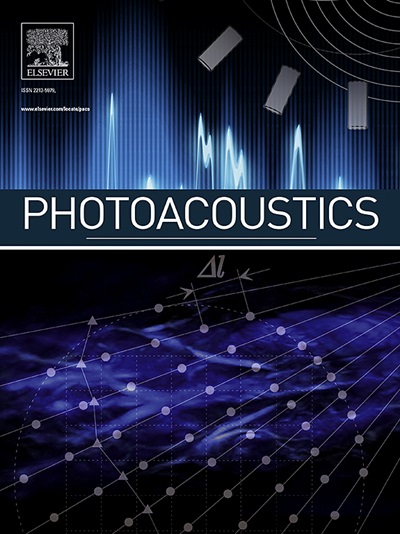基于球囊型光声电池的多光程长度反射增强用于痕量气体传感。
IF 6.8
1区 医学
Q1 ENGINEERING, BIOMEDICAL
引用次数: 0
摘要
针对乙炔(C2H2)气体达到ppb级的检测限制,提出了一种新型球囊型光声电池(BTPAC)。本文采用椭球形光声腔作为气光相互作用的平台。通过有策略地将激励源指向椭球腔的焦点,确保其轨迹在每次从内墙反射时穿过焦点。该路径增加了气体吸收路径长度,提高了激光-气体相互作用过程的效率。实验结果表明,常温常压条件下,BTPAC的品质因子为224.24。值得注意的是,该系统即使在C2H2浓度为0.1 ppm时也能保持高信噪比。最小检出限和归一化噪声等效吸收分别为3.86 ppb和6.94·10-10 cm-1·W·Hz-1/2。最后,当积分时间达到100 s时,传感器的MDL达到0.71 ppb。本文章由计算机程序翻译,如有差异,请以英文原文为准。
Multiple optical path length reflections enhancement based on balloon-type photoacoustic cell for trace gas sensing
A novel balloon-type photoacoustic cell (BTPAC) is proposed to facilitate the detection limitations of acetylene (C2H2) gas achieving ppb level. Here, an ellipsoidal photoacoustic cavity is employed as the platform for gas-light interaction. By strategically directing the excitation source towards the focal point of the ellipsoidal cavity, ensuring its trajectory traverses the focal point upon each reflection from the interior walls. This path increases the gas absorption path length and improves the efficiency of the laser-gas interaction process. Experimental results show that the quality factor of the BTPAC is 224.24 under normal temperature and pressure conditions. Notably, the system maintains a high signal-to-noise ratio even at a C2H2 concentration of 0.1 ppm. Moreover, the minimum detection limit (MDL) and normalized noise equivalent absorption can be calculated to be 3.86 ppb, 6.94·10−10 cm−1·W·Hz−1/2, respectively. Finally, the MDL of the sensor reaches to 0.71 ppb when the integration time reaches 100 s.
求助全文
通过发布文献求助,成功后即可免费获取论文全文。
去求助
来源期刊

Photoacoustics
Physics and Astronomy-Atomic and Molecular Physics, and Optics
CiteScore
11.40
自引率
16.50%
发文量
96
审稿时长
53 days
期刊介绍:
The open access Photoacoustics journal (PACS) aims to publish original research and review contributions in the field of photoacoustics-optoacoustics-thermoacoustics. This field utilizes acoustical and ultrasonic phenomena excited by electromagnetic radiation for the detection, visualization, and characterization of various materials and biological tissues, including living organisms.
Recent advancements in laser technologies, ultrasound detection approaches, inverse theory, and fast reconstruction algorithms have greatly supported the rapid progress in this field. The unique contrast provided by molecular absorption in photoacoustic-optoacoustic-thermoacoustic methods has allowed for addressing unmet biological and medical needs such as pre-clinical research, clinical imaging of vasculature, tissue and disease physiology, drug efficacy, surgery guidance, and therapy monitoring.
Applications of this field encompass a wide range of medical imaging and sensing applications, including cancer, vascular diseases, brain neurophysiology, ophthalmology, and diabetes. Moreover, photoacoustics-optoacoustics-thermoacoustics is a multidisciplinary field, with contributions from chemistry and nanotechnology, where novel materials such as biodegradable nanoparticles, organic dyes, targeted agents, theranostic probes, and genetically expressed markers are being actively developed.
These advanced materials have significantly improved the signal-to-noise ratio and tissue contrast in photoacoustic methods.
 求助内容:
求助内容: 应助结果提醒方式:
应助结果提醒方式:


